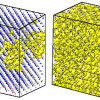News Archive
CRD Method for Understanding Nanostructures Is a Gordon Bell Finalist
The key to energy independence from petroleum, coal and other fossil fuels, could be tiny materials called nanostructures. At approximately 100,000 times finer than human hair, these structures may be microscopic individually, but in groups of thousands, they could revolutionize solar cell design by providing a cost-efficient resource for harvesting solar-energy. Read More »
IMG/M Spearheads Analysis into Human Microbial Communities
Within the body of a healthy adult, microbial cells are estimated to outnumber human cells by a factor of ten to one. These tiny organisms cover every surface and cavity of the human body, forming complex communities that help digest food, break down toxins and fight off diseases. Now scientists will be able to gain valuable insights into how these microbial communities affect human health – with a grant from the National Institute of Health (NIH) and the Integrated Microbial Genomics with… Read More »
LBNL Researchers Contribute to All Aspects of SC08 Conference
Researchers from Lawrence Berkeley National Laboratory are making significant contributions to the SC08 Conference Technical Program, contributing four technical papers and one research poster, organizing two workshops, participating in two panel discussions, and hosting or co-hosting six birds-of-a-feather sessions (BoFs). SC08, the international conference on high performance computing, networking, storage and analysis, will be held Nov. 15–21 in Austin, Texas. Additionally, UC Berkeley… Read More »
Science Studio: Juan Meza Discusses Computational Mathematics in KTEP Radio Interview
Juan Meza, head of Berkeley Lab's High Performance Computing Research Department, was interviewed on the radio program “Science Studio” on El Paso NPR station KTEP on November 2, 2008. In the interview, Meza talks about how the field of computational mathematics helps solve problems encountered with silicon wafers, protein folding, and countless more. He also talks about the stigma of the “geek” factor in mathematics. Read More »
Princeton Has New High-Speed Connection to ESnet’s Dynamic ESnet4 Network
The U.S. Department of Energy’s Energy Sciences Network (ESnet) just improved its Internet connections to several institutions on Princeton University’s Forrestal Campus, including the Princeton Plasma Physics Laboratory (PPPL), the High Energy Physics (HEP) Group within the Physics Department at Princeton University, and the National Oceanic and Atmospheric Administration’s Geophysical Fluid Dynamics Laboratory (GFDL). Read More »
Video Explains How ESnet Supports Large Hadron Collider
The Large Hadron Collider (LHC), a new particle accelerator at CERN in Switzerland, provides a massive facility for physicists around the world to investigate the origins of the universe. The world’s largest scientific research project is expected to produce roughly 15 petabytes (15 million gigabytes) of data annually for analysis. Read More »
After the First Decade of Metagenomics, Adolescent Growth Spurt Anticipated
WALNUT CREEK, CA—Mostly hidden from the scrutiny of the naked eye, microbes have been said to run the world. The challenge is how best to characterize them given that less than one percent of the estimated hundreds of millions of microbial species can be cultured in the laboratory. The answer is metagenomics—an increasingly popular approach for extracting the genomes of uncultured microorganisms and discerning their specific metabolic capabilities directly from environmental samples. Now, some ten years after the term was coined, metagenomics is going mainstream and already paying provocative dividends according to a “Q&A,” News and Views by the U.S. Department of Energy Joint Genome Institute (DOE JGI) microbial ecology program head Philip Hugenholtz and MIT researcher Gene Tyson, published in the September 25, 2008 edition of the journal Nature. Read More »
ESnet4 Rolls Out New Cross-Country 10 Gbps Network
The first national ring of ESnet4 went live over the summer, marking a key accomplishment for a long-term plan to build the next-generation science network for researchers working in DOE's national labs, universities and industry. The network ring, the first of several to be built, runs across the country with northern and southern routes before meeting up at various locations along the east and west coast. ESnet4 will enable researchers to send and obtain raw data and research results at a significantly faster rate and with greater reliability. The infrastructure underlying ESnet4 is a joint project between ESnet and Internet2. Read More »
IMPACTS: On the Threshold of Abrupt Climate Changes
Abrupt climate change is a potential menace that hasn’t received much attention. That’s about to change. Through its Climate Change Prediction Program, the U.S. Department of Energy’s Office of Biological and Environmental Research (OBER) recently launched IMPACTS – Investigation of the Magnitudes and Probabilities of Abrupt Climate Transitions – a program led by William Collins of Berkeley Lab’s Earth Sciences Division (ESD) that brings together six national laboratories to attack the problem of abrupt climate change, or ACC. Read More »
Visualizing the unseen forces of turbulence
Its invisible eddies and vortexes can dramatically alter the flight of everything from golf balls to hypersonic jets. Grasping the vast power of turbulence could help researchers design better weather forecasts, more efficient cars, quieter helicopters and even faster ships that “float” through the high seas on a cushion of air. Read More »







 Instagram
Instagram YouTube
YouTube



